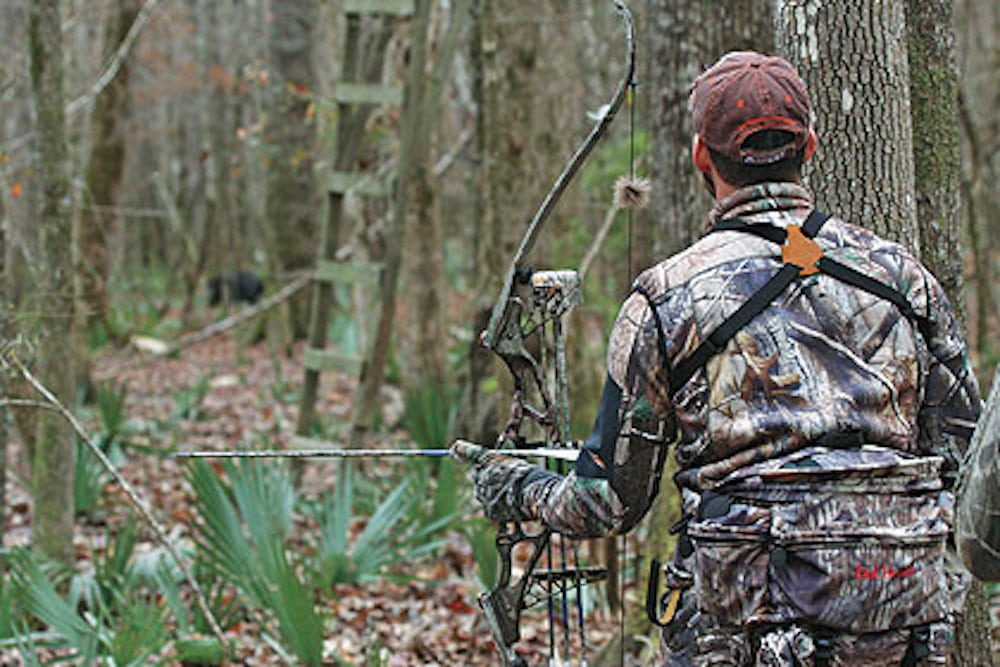Wild hogs are the most populous invasive ungulate in the United States, and they’re wreaking havoc on native habitat everywhere they call home — especially in Texas. With an estimated annual population growth of around 18%-21%, according to the Texas Parks and Wildlife Department, few natural predators, and rapidly increasing range, hogs are expanding northward at a rate of roughly 8 miles per year. The bright side is, liberal harvest regulations make it easy for anyone to hunt hogs, and they’re an exciting animal for bowhunters seeking offseason opportunity.
A hog’s vitals are positioned differently than those of other big-game animals. While their heart and lungs are located behind their shoulders, their large digestive tract tucks these vital organs closer to the front leg. Generally speaking, the vitals on a hog are farther forward than what you’d expect on a whitetail, so you’ll need to adjust your shot placement. But be careful — mature hogs have a thick cartilage shield that extends rearward from their shoulder blade. Shots in this location can result in minimal penetration and a long, disappointing tracking job. Thick, wiry hair coated in mud quickly dulls broadheads upon entry and can further reduce penetration.
Considering all that, it’s important to adjust your gear accordingly. For the most part, your favorite setup for bowhunting whitetails will work, but there are special considerations when choosing your arrow and broadhead combination. Fixed-blade broadheads require significantly less momentum to penetrate than mechanical broadheads. In addition, it’s generally easier to sharpen a fixed-blade broadhead than a mechanical. As a result, bowhunters can hone the edge on their broadhead to ensure it’s capable of penetrating deep into the vitals for a short blood trail and pork on the grill. Pack a punch with high FOC (forward of center) arrows by adding extra weight with stainless steel inserts and other components. Shots are typically close, so heavy arrows and their arcing trajectory won’t negatively impact performance.

Hogs have poor eyesight, so as long as your scent is covered and you’re downwind of the hogs, you can sneak up on them. Photo Credit: Bowhunter.com
There are plenty of methods for bowhunting hogs. Spot-and-stalk hunting is effective and lends itself to active hunters who prefer to sneak to within top-pin distance of their quarry. Hogs have a phenomenal sense of smell, but poor eyesight. Their keen nose amplifies the importance of keeping the wind in your favor throughout the stalk. However, since their eyesight is lackluster, bowhunters can sacrifice cover to keep the wind in their face while sneaking in for a shot. If possible, keep the sun at your back and wind in your face while approaching your target, especially when navigating trail systems cut through the brush. This stacks the odds further in your favor that unsuspecting hogs won’t be alerted of your presence as you make the final approach.
Ambush locations such as treestands or ground blinds are also effective ways to cross paths with hogs. Baiting is typically legal for hog hunting, so consider positioning a bait pile upwind of the prevailing wind direction for your setup. Water holes are also great places to hunt if you don’t have access to a feeder. Position your treestand or ground blind in an area where extra limbs or brush can provide additional cover. Even though their eyesight isn’t the best, it can still be difficult to reach full draw when there are many sets of eyes gathered around a bait pile or water hole.
Bowhunters can even target hogs at night in some states. If your state allows it, it’s an incredibly effective method to consistently put hogs in your freezer. Bait piles or water holes can be rigged with floodlights that are triggered anytime an animal approaches the location, which promotes better shot placement under difficult lighting conditions. Check your state’s laws about hunting at night before you get started, as they can vary seasonally and by location.
Hog populations are growing every year, which poses concerning threats to habitat that supports native species like deer, turkeys and more. Whether your motive for hog hunting is to help conserve habitat, or you just want to get more reps in the field with your favorite archery tackle, opportunity is plentiful.